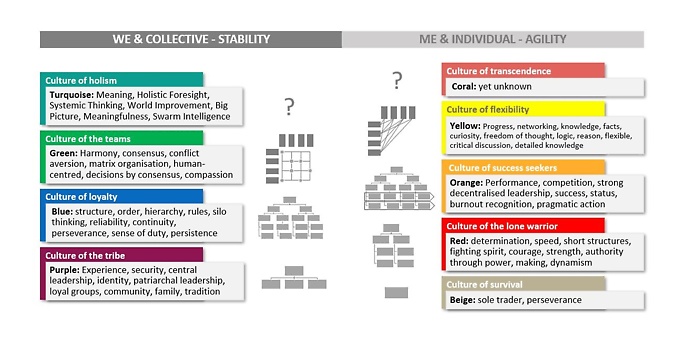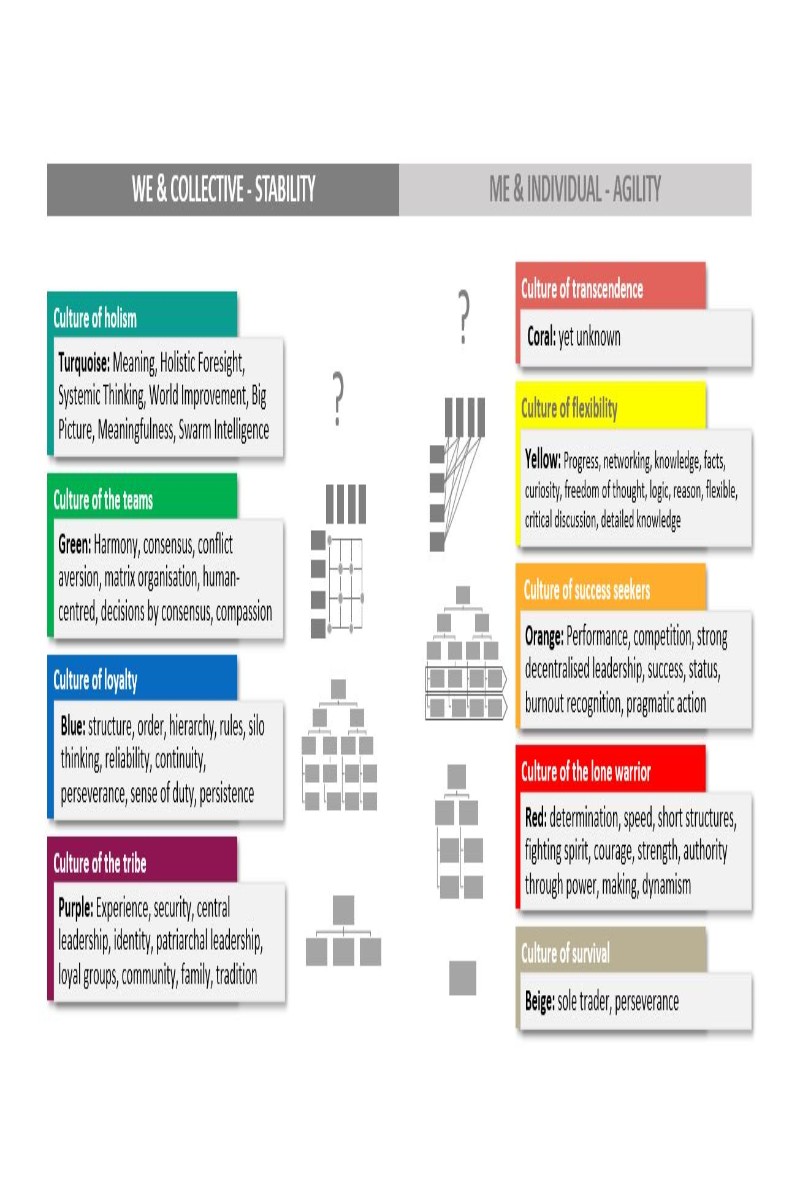28. November 2022 By Mike Deecke
Corporate culture – the rules of the game
Corporate culture – myth or reality?
Is there really such a thing as corporate culture? Or is it simply an illusion we hold? People are constantly trying to figure out what defines a corporate culture and how it can be influenced. However, it is not as simple as that because there is no one single culture at a company. Let’s first take a look at the general theoretical approach to corporate culture.
In the 1950s, the American anthropologist and cultural relativist Alfred L. Kroeber and his colleague, the US ethnologist and sociologist Clyde Kluckhohn, set out to define the term ‘corporate culture’. They came up with 156 different definitions. To this day, there is no general consensus on what corporate culture means. That doesn’t make things any easier.
In general, however, the following can be said: a corporate or organisational culture is a system of shared patterns of thinking, feeling and acting that were developed collectively. It is the sum of existing and lived norms and values. The set of shared and accepted values, norms and attitudes shape the decisions, actions and behaviour of everyone involved. It influences the relationships between individual employees as well as with third parties such as customers and suppliers.
Culture as a game
A game and the rules of the game are a fitting analogy for an organisation and its rules. Organisations are subject to general market rules, or rules of the game. In addition to this, there are various legal regulations and rules that apply in a specific sector. If you drill down and take a closer look at an organisation, the individual rules begin to come to the fore. This makes organisations unique and sets them apart from each other. In a matter of speaking, the set of normative, formal and informal rules reflect the rule by which the organisation operates.
Those in the game want to stay in it as long as possible and have fun. They play by the rules, which are the terms of membership. If you do not agree with the company rules, you are free to change them or leave the company. In other words, love it, change it or leave it.
The rules of the game can be broken down into different categories. There are the official rules like ‘all requests for time off must be made in writing’. Then there are the unofficial rules such as ‘employees with school-age children will be given priority in holiday planning’. In most cases, these rules are not necessarily different from one company to the next. They are more or less the same within a particular region or country. External rules of the game or culture often trump internal ones. If you live and work in Wolfsburg, some decisions may depend on the results of the local football match.
Here, however, there are no set boundaries. It all flows together. This could be rules in place within a particular subculture at the company, for example, ‘if the home team wins the tournament, everyone will get the next day off to mark the victory’.
Parallel cultures in the double helix
There is no one single culture at a company. Every division, department, team or group has its own culture and its own rules. In one department, work is done strictly by the book, while a more laissez-faire approach may be taken elsewhere. In spite of this, both of them work efficiently.
It is easy to see that a culture can only ever exist among groups with two or more members. The beige culture (individual entrepreneur) as described in Professor Clare W. Graves’ double helix of corporate cultures is therefore not relevant here. There are still a number of cultural manifestations left to explore in the model which we will go into now.
Clare W. Graves was an American professor of psychology and originator of the emergent cyclical theory of adult human development. A double helix model emerged based on his concepts that clearly describes the different aspects of corporate cultures.

The nine levels of value systems model represent a spiral staircase with nine levels. In each case, the ‘I’ perspective alternates with the ‘we’ perspective. Graves chose a different colour for each level. The model starts on the first level (beige). The culture of survival, as previously described above, is not relevant in the business context since it is the culture of the individual entrepreneur. The purple level is the first ‘we’ culture. As in a tribe with central leadership, there is cooperation and minimal division of labour. This is followed by the red level, which has few rules and lots of energy and dynamism. This level is described as a culture of lone wolves and is on the ‘I’ side. One step above this on the ‘we’ side, we come to the most common type of corporate culture. The blue level is the culture of loyalty, with a high standard of quality achieved through rather inflexible rules. Unfortunately, the well-known silo thinking associated with strict hierarchies is to be found here. On the orange level, there is increased collaboration once more. The ‘we’ culture of success seekers is fast, very tech-savvy and characterised by highly decentralised leadership. The team culture inhabits a green matrix organisation. If there is an openness to dialogue, a process-oriented approach can be taken in a highly collaborative environment. This is followed by the yellow level with high diversity and the turquoise level with swarm intelligence. The top level – the coral-coloured culture of transcendence – has yet to be defined in terms of its shape or form.
The German economist Dr Simon Sagmeister makes direct reference to the Graves model in his book ‘Business Culture Design’. Sagmeister ignores the first and final levels.
Humanity in cultures
People work at companies. Every person is different and brings their own story with them. Their expectations are just as varied as their intrinsic motivation. Companies are complex organisations, which means that a standard cause-and-effect principle does not apply here. Corporate cultures can be distinct if there is acceptance for this. They cannot be directly influenced or guided in one direction or another.
As such, employees may have close personal relationships with each other. People communicate and may make decisions differently under these conditions. These informal channels have an indirect influence on the corporate culture.
Employees’ desires and needs have evolved and go beyond simple monetary rewards. Being able to play table football in the office, on the other hand, is not enough to foster successful teamwork. What a company needs to do is to recognise that many changes and adjustments can be made and to make them.
However, it is possible to outline a basic direction for cultures at a company. Managers can choose a particular type of leadership style. As shown in Graves’ model, the ‘I’ or ‘we’ perspectives can be represented in this way. If the company has a traditional patriarchal management approach, ‘leading by fear’ is a direct method to create this type of corporate culture.
Formal rules of the game can influence corporate cultures in an indirect way. They can but do not necessarily do that. Organisational structures also have an indirect influence in the form of silos, process orientation and networking. However, it is not possible to choose the characteristics that the cultures at a company will have. Culture is the shadow of the past, and it is constantly evolving.
What are successful corporate cultures?
A successful work culture is all about the people who make it up. The needs and requirements within the company –and within the teams – determine the criteria for success. As always, it depends on the actual objective being pursued. Oftentimes, high employee satisfaction is a success criterion for ‘good’ corporate cultures. Depending on the perspective, additional objectives can also be considered. Having teams that work efficiently can also be a goal.
The GSG 9 special unit of the Germany Federal Police has different cultural values than a team of game developers. One is based on having full and complete trust in your fellow officer, while the other is all about creativity. It is therefore clear that Graves’ level model does not mean that a higher level is necessarily better. The model simply lays out the value-free attributes in order to make it possible to differentiate between the different levels.
The criteria that determine the success of corporate cultures depend heavily on the business model and the business goals as well as the changes made to structures and business processes in response to this. Ultimately, it comes down to finding the perfect fit between the company and its employees. For that reason, the ability to continuously train and attract new global talent is key to fostering a positive culture.
How to influence corporate cultures
Corporate cultures cannot be directly influenced through norms. Simply saying that ‘from now on everyone is a team player’ will not make it so. The company’s mission has a major influence on the development of its corporate culture. Managers always serve as role models and drivers. They need to be aware of their public role.
Managers are role models for their employees, though there are also other things that motivate their actions. Basically speaking, there are four motivations for action: fear, utility, gratification and sense of purpose.
In a heavily top-down corporate culture, fear of failure can drive action on the other side. This method of motivating employees is outdated and fortunately not very common anymore. Extrinsic motivation only works as long as there is additional utility. This also hold true when gratification is the driving force behind certain actions. Where the actual purpose of an action is understood and found to be good, we speak of intrinsic motivation. This is the motivation for good corporate culture that companies strive for.
The success criteria necessary to have a positive influence on cultures within a company are as follows:
- High employee satisfaction -> utility and gratification
- Large number of applications received > utility, gratification, sense of purpose
- Desirable values are practised > utility and gratification
- Intrinsically motivated employees > sense of purpose and vision
The following aspects are considered informal factors that influence corporate cultures:
- Working environment: Suitable location and room concepts
- Building, offices, places to relax and decompress
- HR management: Recruit and integrate suitable employees
- Recognise and promote individual professional values and talents
- Cherish and incorporate individual experiences and stories
- Leadership: Appropriate behaviour of managers, for example:
- Managers as role models
- Lead not manage
- Open door policy for managers
- Networking: Appropriate communication, for example:
- Sufficient level of transparency as to how decisions are made
- Tight feedback loops with employees
- Personal, human-centric communication
- Innovation: Meet needs not requirements
- Respect different team-specific cultures
- Take innovation seriously
- Symbols: Meaningful and appropriate signs and mantras, for example:
- Suitable project names
- Artefacts – what we do
- Values – what we say
- Beliefs – how we think
- Methods: Appropriate working methods based on the relevant situation, for example:
- Agility, lean or traditional waterfall models
- Strict procedures or guidelines
- Roles and duties: Clear-cut roles with defined areas of responsibility, including:
- Senior and middle management for strategic decisions
- Process coordinators and owners for operational decisions
- Application coordinators and owners for technical and functional decisions
Conclusion
There are many cultures at a company that exist side by side. They are key building blocks for any successful business. It is crucial for companies to be proactive in defining and developing their work culture, especially in times of rapid growth and change.
A company is an organism with a life of its own. It is dynamic and constantly evolving. Investments in corporate culture pay off, though the outcome is difficult to predict. One targeted action is never enough to achieve the desired goal. Permanent monitoring is required.
Managers have a major influence on corporate cultures and should use this power wisely. At the end of the day, every employee shapes and lives out the corporate cultures through their stories and experiences.
What we have to offer
Transformations have an impact on the cultures within your company. adesso is there to support you as you define and implement your ideas to create robust cultures. Along with that, we also provide ongoing assistance and implement transformation projects for you.
Our organisation management specialists are easy to reach and more than happy to discuss ways to make your company even more successful in the future. Contract us at organisationsberatung@adesso.de
Would you like to learn more about exciting topics from the world of adesso? Then check out our latest blog posts.


